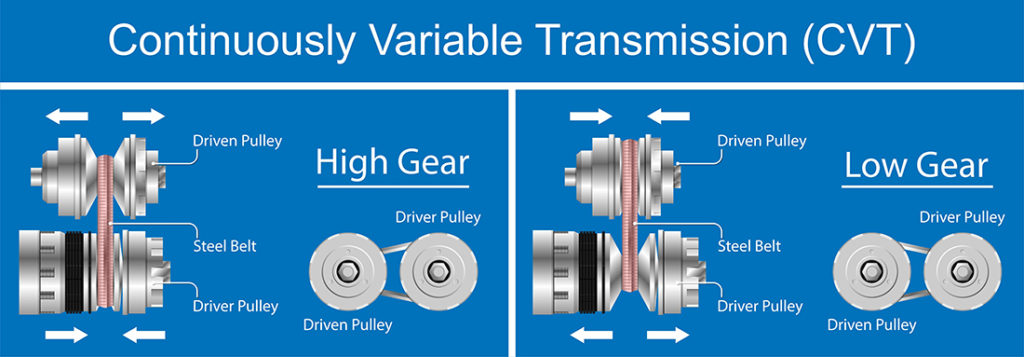What Is A CVT Transmission?
Bass Transmissions in Roanoke, VA, is your authority on servicing CVT transmissions. Continuously variable transmissions (CVT) are not a new invention in the world of internal combustion engines and transportation. They have, however, seen a rise in popularity in larger passenger vehicles since the 1980s. CVTs are a fuel-efficient option vs. linear transmissions with clutch plates, planetary gearsets, torque converters, and other moving parts. Our team of experts here at Bass Transmissions can give some important information about CVT transmissions and when or when not to service them.
CVTs Have Three Basic Parts, Infinite Gears
The most popular type of CVTs use pulleys and a V-shaped belt. The pulleys consist of two cone-shaped halves that move together and apart. The V-belt runs between these two halves. The diameter of the pulley changes if the cone-shaped halves move closer together or farther apart. The gear ratio changes by moving the two cones of one pulley closer together and the two cones of the other pulley farther apart. The distance between the pulleys and the length of the belt does not change. But both pulleys must move simultaneously in order to keep the right amount of tension on the belt.
Simple CVTs use a weighted drive pulley with a spring-loaded driven pulley working together with the belt tension to make “gear changes.” CVTs have a few other variations in which they all perform differently and are found in different types of vehicles. Do you want to learn more about which cars have CVTs? Take a look at this article from cars.com.
From Motorcycles to Mining Trucks, CVTs Are Everywhere
Milton Reeves, an early trendsetter and visionary in the automobile industry, invented a CVT — then called a variable-speed transmission — for use in sawmilling in 1879. He noticed that saw mill workers used a simple pulley system to power the saws and were not able to adjust the speed. This resulted in large amounts of wasted wood. Months later, Reeves began adding this transmission to his own line of cars. Reeves is thought to have built either the fourth or fifth American automobile, called a “Motocycle” at the time. He employed his belt and pulley-based CVT transmission, making his invention arguably better than Henry Ford’s one-speed Quadricycle.
CVTs Are Speeding Up in Popularity
CVTs began to see a rise in popularity for motorcycle transmissions. They take up a small amount of space, allow for the maximum amount of engine power to go to the wheels, and are incredibly fuel efficient. CVTs also have lower production costs because they have fewer moving parts than traditional automatics. This makes them an almost perfect choice for modern fuel-efficient, hybrid, and full-electric vehicle manufacturers.
CVTs In Modern Cars Are Difficult and Expensive to Repair
While CVTs are built to last the lifetime of the car or about an average of 100,000 miles, they come with a few other disadvantages. Some of the common problems that CVT car owners face include overheating, slipping, and sudden loss of acceleration. Shuddering is also a common problem. CVTs also depend on the belts to operate. If the belt begins to weaken from excessive stretching or too much wear, the transmission can completely fail.
If you own a car with a CVT transmission and begin to experience issues, bring it in to our team at Bass Transmissions. Transmission work can be some of the most complex repairs to make to your car. Trust us to go over every part of your transmission to find the source of the problem.
For more information on servicing CVT transmissions, give Bass Transmission in Roanoke, VA, a call at (540) 345-8871. Like us on Facebook to stay up-to-date with the latest news and information. We are happy to discuss more information about serving CVT transmissions.

